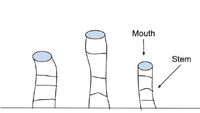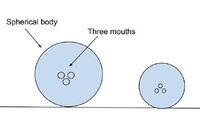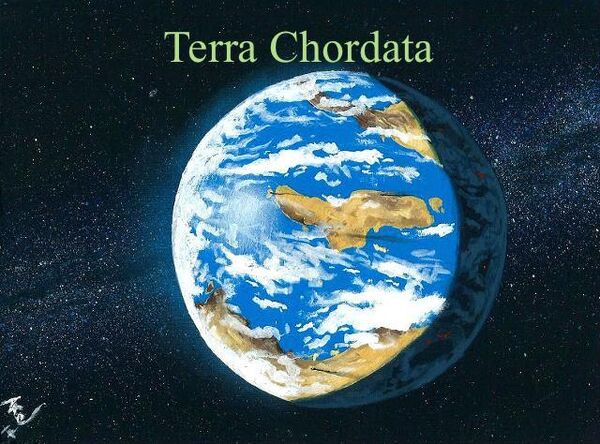| Terra Chordata | |
|---|---|
| Astronomy and Geology | |
| Auster • History of Auster | |
| Life Forms | |
| Benthochordata • Thalassaflora | |
- See also: Terra Chordata § Benthochordata
The Benthochordata are a group of tunicates resembling echinoderms. They are quite diverse, containing over 40,000 species. They take forms like sea cucumbers, sea urchins, and tube worms. Many species are radially symmetric. Most species are benthic, although the depth at which they live greatly varies. All species possess a similar type of mouth, usually a round opening through which they feed on phytoplankton or zooplankton. The small siphon through which water is expelled in all modern ascidians in gone in this clade, to be replaced by small pores. This is possibly the only feature uniting this wildly diverse group.
Evolution[]
The Benthochordata evolved from Clavelina moluccensis, one of the two tunicates and the only ascidian introduced to Auster. Over 90 million years, they diverged and evolved from previous groups, and finally diverged from a usual ascidian. The ancestral benthochordate was a tube worm-like form, and had a mouth hole, similar to the basal Helminthochordata. However, the Helminthochordata may not be basal, but paraphyletic, with one branch of helminthochordates evolving into the other forms. The height of benthochordate evolution is the Occulobenthi, yet another group of "neovertebrates".
Early Benthochordata[]
The first benthochordates, as previously mentioned, were very similar to the Helminthochordata. However, what they lacked was the solitary lifestyle of most helminthochordates, preferring to live in colonies. This is one reason why it is not certain that Helminthochordata is paraphyletic. Several extinct groups of primitive benthochordates existed, each one with a radically different lifestyle.
Pelagicylindria[]
One primitive order, the Pelagicylindria, were free floating cylinders, effectively plankton. They would swim by expanding and contracting their bodies, like jellyfish. At the peak of their diversity, 120 million years after introduction, they had about 2,000 species, however, by this time the Thalassaflora, an unrelated tunicate group with a similar niche, had diversified as well. Their better adaptations to a pelagic life soon led them to outcompete the Pelagicylindria. The second mass extinction also greatly weakened them. Continually outcompeted by the Thalassaflora, the order was pushed to extinction not long afterwards. The Thalassaflora went on to become one of the most successful groups in Auster's history, reaching 200,000 species at the time mentioned.
Crinochordata[]
Another basal group was the Crinochordata; like helminthochordates, but with tentacles. This group was predatory, and very similar to sea anemones in appearance and lifestyle. However, these were not the most successful predators in the sea, and despite the fact that Auster seems devoid of predators, the sessility gave them a disadvantage against the ever superior Hexapterygii. Not only were they sessile, but they were quite obvious animals, unlike the later predatory Platyconidae. They were ultimately wiped out in the second extinction.
Other Extinct Groups[]
The more primitive groups went extinct by out-competition or during the second extinction, but these more derived groups went extinct during the Nyx Traps, the worst extinction in the planet's history. These include mostly intermediate members of the Eubenthochordata.
Pseudoechina[]
The Pseudoechina are similar to echinoderms, and since their evolution, 220 million years after introduction, have been dominant. They include many little-known forms, such as the strange Echinolimax, which went extinct during the eruption of the Nyx Traps, mostly due to chance. Echinolimax is notable for being very common before the Nyx Traps, and extinct afterwards. Despite the fossils being common, Echinolimax is poorly understood, as its relations in Pseudoechina are ambiguous. Echinolimax, despite looking like a stretched out version of the Nothechinidae, was not closely related to either of the two living orders, and was an evolutionary "side branch". All Spheracizoa have three mouths, and their ancestors had three mouths, with the only difference being the flattened out body. Either the one-mouthed Echinolimax was a very basal spheracizoan relative, or part of an unusual clade called the Xenechina. Most of these side branch Pseudoechina are not assigned to an order, but are placed in one of the three main clades: Pan-Spheracizoa; Pan-Decasteria; and the strange Xenechina (which may include Echinolimax), which may be a wastebasket taxon.
Occulobenthomorpha[]
The Occulobenthi are a very new group to Auster's oceans, having existed for only 40 million years before the time mentioned, but their ancestors are as old as the Pseuoechina. Most Occulobenthomorpha had slug- or sea cucumber-like forms, but with a head, retained in the later Occulobenthi. They have a long line of benthic invertebrates leading up to the umpteenth cartilaginous skeleton, which existed in the closest relatives of the Occulobenthi. The last development was the eyes, which are one of the things defining the Occulobenthi as different from their relatives. Most groups went extinct due to the Nyx Traps; like the Pseudoechina, they survived with only a handful of species which diversified later.
The first member of Occulobenthomorpha was a sea cucumber-like form, with the mouth on what was to become the head. This position of the mouth was retained in all later species. The Occulobenthomorpha were preyed on heavily, and so around their notochord formed a cartilaginous structure, which protruded out of the skin in spines. However, these spines only stayed for one stage of the evolution, and eventually they used their backbone in order to make moving more efficient than in other Benthochordata. So, they were able to move like an inchworm in later Occulobenthomorpha. The Occulobenthi themselves are distinct in having eyes. Certain species possess a "jawed" mouth, but in reality this is a different eating mechanism.
Cladogram[]
The following is a simplified cladogram of the Benthochordata, excluding extinct groups.
| Benthochordata |
| ||||||||||||||||||
Helminthochordata[]

Basic anatomy of a helminthochordate
The Helminthochordata are the most diverse as well as the oldest order of Benthochordata. Although the Pseudechina are considered dominant, they fill a higher trophic level, and thus have less biomass; they are less diverse. Approximately 23,000 species of helminthochordate exist, more than half of all benthochordate species. They are put into eight slightly distinct families, of which it cannot be said which one gave rise to the Eubenthochordata.
Cylindrihelminthes[]
The first and most primitive suborder, the Cylindrihelminthes, are comprised of three families. This group is characterized by their tall, cylindrical shape and their unspecialized feeding habits, simply eating whatever lands in their mouths. The first family, Pilosastomatidae, have "hairs" in their mouths in order to capture zooplankton. The second family, Pseudohelminthidae, are the most tube worm-like of all the families, and have a long, thin body. The last cylindrihelminthian family is the Cylindrihelminthidae, which look like an outstretched version of their ancestor, Clavelina moluccensis. The Cylindrihelminthidae are almost entirely restricted to the midnight zone, with other areas of the ocean being colonized by the Sinexena. Despite their diversity (they are the largest group of helminthochordates), this suborder is not very different in its forms; they are the most diverse group of helminthochordates, with the Cylindrihelminthidae anatomy being used in the diagram.
Conocorpia[]
The second suborder, Conocorpia, have cone shaped bodies, although which side is tapered depends on the species. However, each of the two families have a different feeding habit, leading to one orientation being used more commonly in each family. The Conocorpidae usually has the tapered end on the bottom, as their feeding strategy is to filter in as much zooplankton as possible. However, some members are reversed, due to the fact that their environment is more similar to the typical environment of the next family. The second family, the Platyconidae, likes to attract larger prey, namely Xenopisces. They are flat, with a smaller hole, which the Xenopisces will swim through, thinking they have encountered algae. They will remain trapped in the platyconid, and will be digested.
Caulohelminthes[]
The third suborder is a relict group, containing only one genus, which lives in the famous Chronos Ocean. The suborder is named Caulohelminthes, with the living genus named Caulohelminthis in the family Caulohelminthidae. With its kin wiped out by the Nyx Traps, Caulohelminthis is a living fossil. The members of the genus (about 12 species) have stalks, on the end of which is a cone-shaped tube. Through this, it filters in zooplankton, in a way similar to the more successful Conocorpidae. The stalk is up to three times longer than the body itself. In the Chronos Ocean, certain species of Caulohelminthis may form reefs.
Euhelminthochordata[]
The last suborder, Euhelminthochordata, despite being called the "true" helminthochordates, are the most atypical group. They are united by their small amounts of motility. They are not attatched to a substrate, and so look like "ordinary" polychaete worms. The two families are Helminthochordatidae (despite bearing the name of the order, they are not representative); and the uncommon Parasitichordatidae, which are parasites of lancelets. Only seven species in Parasitichordatidae exist, not because they are relicts, but because they are a recently evolved group.
Cladogram[]
The following is a cladogram of the helminthochordate families.[note 2]
| Helminthochordata |
| |||||||||||||||||||||||||||||||||||||||
Spheracizoa[]

Anatomy of a spheracizoan; looks like a living bowling ball

A trio of spheracizoans from the Pachytestidae family

A triproboscidean from the Floraphagidae family capturing a xenopiscean
The Spheracizoa, commonly known as spheracizoans or three-mouthed urchins, are a group of spherical benthic Pseudechina. They are divided into two suborders. Among their seven families are around 4,000 species, less than Helminthochordata and Decasteria, but more than Occulobenthi. Although they may appear sessile, most species possess a foot on the bottom of their bodies, moving in a way similar to gastropods. On their lateral surface are three mouths, arranged in a manner so that they look like living bowling balls. The group as a whole evolved 280 million years after introduction, right after the Nyx Traps eruption.
Spheracigastropoda[]
The more successful of the two spheracizoan suborders, the Spheracigastropoda are motile. They have a single foot, giving them a name which includes -gastropoda. The two suborders are only distantly related, considering their radically different adaptations. Both suborders have extensive pan groups, and there is no subgroup of Sphercizoa which includes both living suborders. There is noticeable difference among the five families, which fall into two superfamilies. The first superfamily is Spiralispheracoidea, which have spirally curved "tests". Out of this, the two families, Spralispheracidae and Noctospheracidae, differ only in location, the Noctospheracidae living in the midnight zone. The Allospheracoidea contains many radical and unusual groups, put in the families Allospheracidae, Nothechinidae, and Pachytestidae. The Allospheracidae are somewhat oblong shaped, unlike all other spheracizoans. The Nothechinidae have small spines, just like sea urchins, and the Pachytestidae have "tests" which are twice as thick as in other spheracizoans. The only feature uniting all Allospheracoidea is the lack of a spirally curved shell. Despite Allospheracoidea containing more families, in terms of species Spiralispheracoidea is more diverse. All Spheracigastropoda are filter feeders.
Triproboscidea[]
Unlike many benthochordates, which filter food in through their mouths, the spheracizoan suborder Triproboscidea has probosces inside each of their three mouths. Unlike the Spheracigastropoda, they lack a foot, and are mostly sessile. Although they mostly feed on plankton, the occasional small lancelet or tunicate will be eaten. Sometimes being predators, they make up a minority of the Spheracizoa, with only 700 species out of 4,000 being in this suborder. They contain two families, Quasiproboscidae, which cannot snatch up larger prey with their probosces, and thus are filter feeders; and the less common but more advanced and predatory Floraphagidae, which feed mostly on Thalassaflora, which are somewhat like jellyfish; and Xenopisces, which are semi-conservative lancelets.
Cladogram[]
The following is a cladogram of the spheracizoan families.
| Spheracizoa |
| ||||||||||||||||||||||||||||||||||||
Decasteria[]

Ten-fringed decaster showing circular mouth
Occulobenthi[]

Anatomy of an occulobenth; evidently more derived than other benthochordates


